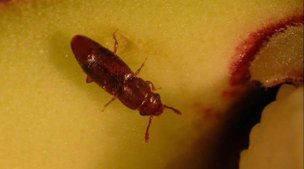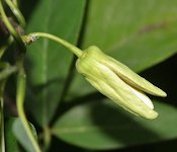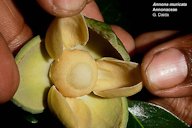Annona Flowering Behavior, Pollination, and Fruit Set From the Horticultural Sciences Department, Florida Cooperative Extension Service Institute of Food and Agricultural Sciences, University of Florida Sugar apple trees produce flowers on 1- to 2-year-old wood and newly emerging shoots. Natural fruit set ranges from near zero to about 3%, and fruit production may be severely limited by poor fruit set and fruit shape. This is due in part to the absence of their natural nitidulid beetle pollinators in some areas and/or a lack of sufficient pollination during flowering. Misshapen fruit is caused by incomplete pollination. 1 Atemoyas and sugar apples are most often pollinated by nitidulid beetles (sap beetles), which breed and feed in decaying fruits or sap flows. The beetles are attracted to the fruity, fermenting odor of Annona flowers. The activities of beetles in the flowers, including feeding and mating, result in prolonged visits from several hours to a few days while the flowers advance from the female to the male phase. The number of beetles per flower affects the likelihood of fruit set, and also the quality of the fruit in some cases. 2  Fig. 1  Sap beetle Carpophilus lugubris entering a A. muriticata flower The number of beetles per flower affects the likelihood of fruit set, and also the quality of the fruit in some cases. Studies provide evidence for increased fruit set as numbers of visiting beetles increase (Nagel and Peña 1989). Trials to increase fruit set in atemoya orchards by augmenting sap beetle populations have yielded mixed results. Pollination by sap beetles can be improved by using chemical lures. Peña (2002) reported increased fruit set using nitidulidpheromone bait stations on sugar apple and atemoya in south Florida. In Florida, flowering of atemoyas begins in April, and sugar apples in May, and continues until early August. Nine species of native and exotic nitidulids visit the flowers, but Carpophilus mutilatus is the most important pollinator regarding efficacy and abundance in flowers, followed by C. fumatus and Haptoncus luteolus (Nagel and Peña 1989). 2 Flowers of sugar apple in the female stage are characterized by only a slight opening of the petals (Fig. 2) and a glistening appearance to the stigmatic surfaces (Fig. 4). Flowers in the male stage are characterized by flower petals being wide open (Fig. 3), petals may easily fall when touched and stamens may have a brownish color. This arrangement of having male and female flower parts functional at different times during the day makes cross pollination among different flowers necessary. 1 Table 4. Flowering behavior of sugar apple flowers
Flowers that open under conditions of high humidity and warm temperatures are more likely to set fruit than those flowers opening during low humidity and/or cool temperatures. This is because a dry atmosphere more rapidly desiccates the female flower parts than a humid atmosphere. 1 Hand pollination of atemoya and sugar apple is possible and may be very effective in improving fruit set (up to about 50%) and fruit shape. In general, pollen is collected from stamens of flowers in the male stage, which may be late afternoon, early evening, and early morning. The petals should be nearly fully opened and the pollen sacs should have turned creamy-grey in colour and less tightly held together. Immature pollen sacs are white and tightly packed. 3 The collected flower may be placed on paper where the anthers (male flower parts) are allowed to dehisce (release pollen). The next morning the pollen may be mixed with talcum powder to improve handling and transferred to flowers in the female stage of development. Hand pollination is usually most successful in the early to mid-morning hours (sunrise to about 11:00 am) and is done by using a thin camel-hair paint brush (like the brush found in water color paint set) to transfer pollen through the slightly open flower petals of the female stage flowers to the stigmatic surfaces at the base of the flower. 1
Further Reading Hand Pollination of Custard Apples, Archives of the Rare Fruit Council of Australia Key Issues: Pollination, Dept. of Primary Industries, Queensland Horticulture Institute Back To Atemoya Page Cherimoya Page Custard Apple Page Sugar Apple Page |
||||||||||||||||||||||||||||
| Bibliography 1 Crane, Jonathan H., et al. "Sugar Apple Growing in the Florida Home Landscape." Horticultural Sciences Dept., UF/IFAS Extension, HS38, Original pub. Oct. 1979, Revised Apr. 1994, Oct. 2005, Nov. 2016, Reviewed Dec. 2019, AskIFAS, edis.ifas.ufl.edu/mg330. Accessed 2 May 2018, 28 Oct. 2020. 2 Carrillo, Daniel, et al. "Pollinator and Insect/Mite Management in Annona spp." Entomology and Nematology Dept., UF/IFAS Extension, ENY-834, Original pub. July 2006, Revised Aug. 2017, AskIFAS, edis.ifas.ufl.edu/ig166. Accessed 2 May 2018. 3 George, A., et al. "Hand Pollination of the Custard Apple, A DPI Technical Feature." Archives of the Rare Fruit Council of Australia, Queensland Fruit & Vegetable News, 16 Nov. 1995, rfcarchives.org.au. Accessed 31 Dec. 2014. Videos v1,2,3 Crane, Johathan H., and Ian Maguire. "Cultural practices for the sugar apple." University of Florida, IFAS/TREC. Photographs Fig. 1 "Sap beetle Carpophilus lugubris entering a Annona muriticata flower." Entomology and Nematology Dept., UF/IFAS Extension, ENY-834, Original pub. July 2006, Revised Aug. 2017, AskIFAS, edis.ifas.ufl.edu/ig166. Accessed 29 Jan. 2014. Fig. 2 Garg, J. M. "Annona squamosa (Custard Apple) flower in Hyderabad." Wikipedia, 2008, wikipedia.org. Accessed 27 Aug. 2014. Fig. 3 Ks. mini. "Annona reticulata." Wikimedia Commons, 2011, commons.wikimedia.org. Accessed 31 Dec. 2014. Fig. 4 Daida, G. "Sticky stigma covered in pollen." University of Hawai'i, Botany Department, Mānoa Campus Plants, botany.hawaii.edu. Accessed 29 Aug. 2014. Published 20 Jan. 2016 LR. Last update 30 July 2021 LR |
||||||||||||||||||||||||||||

